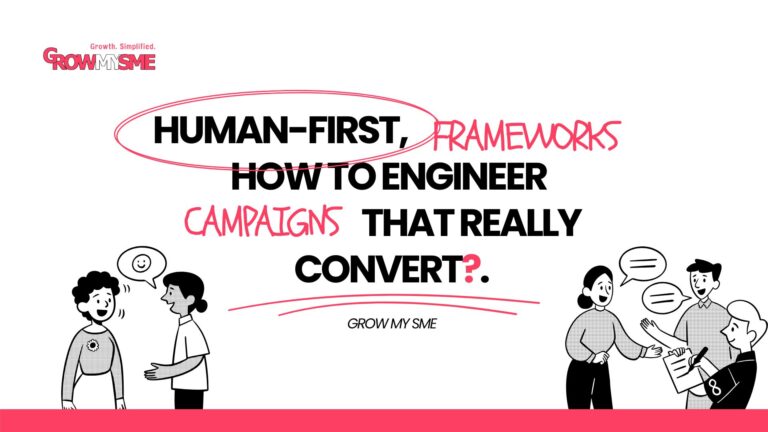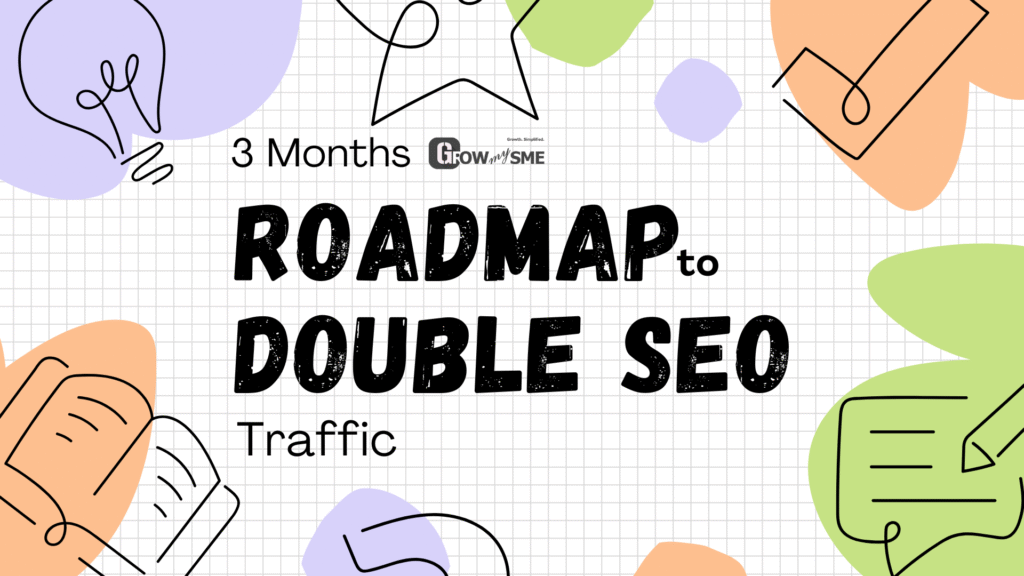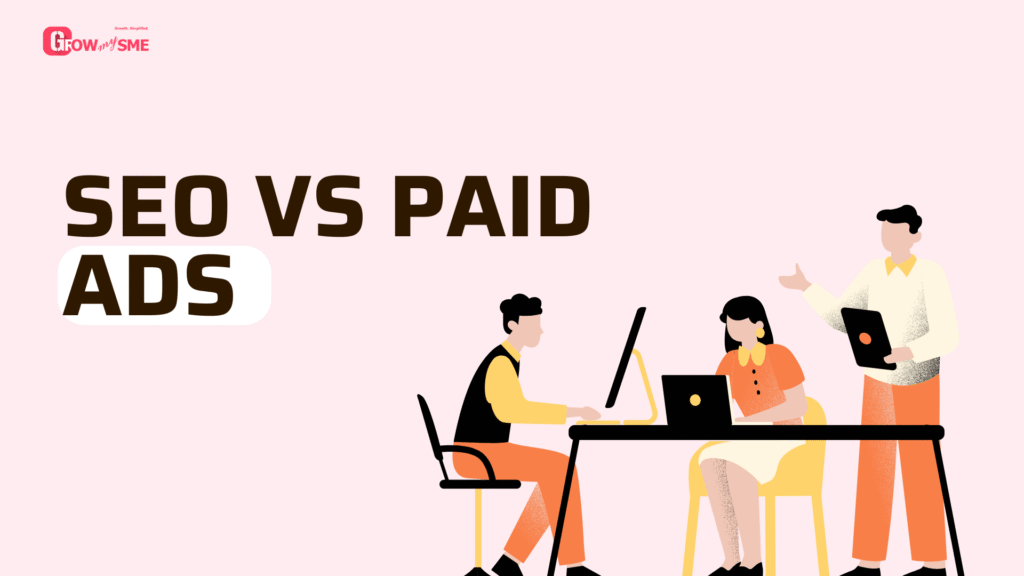Let’s be honest:
Most SME marketing campaigns are built on a broken foundation.
They focus on features (“We do Facebook ads!”) instead of psychology (“Your customers are anxious about looking cheap.”).
The result? Crickets. Low-quality leads. Wasted budgets.
But here’s the good news:
When we analyzed the data from 1,200+ lead gen campaigns for small businesses, a pattern emerged. The winners all used the same psychological levers.
For example, by applying this “human-first” framework, we helped a local bakery increase qualified leads by 42% in 60 days — one of our most effective local business growth strategies. Not just clicks—actual, ready-to-buy customers.
In this post, I’m going to show you the exact 3-step framework we use to engineer campaigns that convert — similar to our proven B2B lead generation frameworks that consistently turn cold audiences into booked calls. It’s not about more marketing; it’s about smarter marketing — and building repeatable marketing systems that drive consistent growth.
Let’s dive in.
The “Buyer Psychology” Gap: Why Your Campaigns Are Failing
Here’s a hard truth we learned the hard way:
Tools don’t convert. Psychology does. The same principle powers our data-driven eCommerce growth systems, where psychology drives performance—not just platforms.
We once ran a Facebook ad for a furniture maker that got 1,200 clicks. Sounds great, right?
Only 8 people called.
That’s a 0.66% conversion rate. A disaster.
Why did it fail? We were talking about us: “Handcrafted oak furniture.” But the buyer was thinking about them: “Will this make me feel proud when friends visit?”
The Fix: We reframed the entire campaign around the customer’s internal dialogue.
Old Ad (Feature-Focused): “We Manufacture Fine Oak Furniture”
New Ad (Psych-Focused): “Own Furniture Your Guests Will Compliment. Booked Slots Are Limited.”
The result? Conversions jumped to 2.5% in one week—a nearly 4x increase.
This proves a critical point: Beating the average conversion rate (which hovers around 2.35% for Meta ads, according to a recent WordStream study) isn’t about spending more. It’s about thinking differently and improving marketing ROI for service businesses.
The 3-Step “Human-First” Campaign Framework
After testing hundreds of variables, we distilled our winning formula into three repeatable steps.
Step 1: The “Jobs-To-Be-Done” Deep Dive
Forget demographics. The key is to uncover the “job” your customer hires your service to do.
Example: A lawn care client doesn’t buy “mowing.” They “hire” you to make their home the envy of the street and relieve their weekend chore stress.
Your Actionable Tactic:
Conduct a “5 Whys” Interview with your best past clients.
- “Why did you choose us?” (“You had good reviews.”)
- “Why were reviews important?” (“I was worried about hiring someone unreliable.”)
- “Why was that a worry?” (“I didn’t want my property damaged.”)
- …and so on.
You’ll hit the core emotional driver: relief from anxiety.
Step 2: Embed the 3 Conversion Triggers (The “Mind-Switch” Trio)
Every touchpoint in your campaign must flip one of these three psychological switches.
| Trigger | The Wrong Way | The Right Way (Example) | Result |
| Instant Clarity | “We provide holistic digital marketing solutions.” | “Get 10 booked calls from local customers this month.” | 33 form-fills in 4 days (vs. 12 the prior month). |
| Social Validation | “We’re the best in the business.” | “Join 37 other local SMEs using our system to fill their booking calendars.” | Calls increased by 18% in one campaign cycle. |
| Pain-Agitation | “We can help you grow.” | “Your competitors are capturing your ideal clients right now. Every day you wait, you lose a booked slot.” | Created urgency without being sleazy. |
Step 3: The “Micro-Commitment” Funnel
Don’t ask for the sale upfront. Engineer a path of small “yeses.”
This is how we structure it:
- Ad: Offers a high-value, low-commitment lead magnet (e.g., “The 5-Point Lead Flow Audit”).
- Landing Page: Uses the triggers from Step 2. The CTA is “Download Your Free Audit.”
- Thank-You Page: Immediately offers the micro-commitment: “Book a 15-Minute Strategy Session.”
- Email Sequence: Delivers the audit and reinforces the value of the call.
This method respects the buyer’s psychology and dramatically increases qualified bookings.
Case Study: How a Local Consultancy Went from 0 to 4 High-Ticket Clients in 45 Days
The Problem: A new local business consultancy had zero inbound leads. Their messaging was generic: “We help businesses grow.”
Our “Human-First” Fix:
- Jobs-To-Be-Done Deep Dive: We discovered their clients were first-time founders overwhelmed by operational chaos. The “job” was to restore a sense of control and predictability.
- Messaging Pivot: We changed their headline from “Business Growth Consultants” to “The Operational Control System for Ambitious Founders.”
- The Campaign: We ran a targeted LinkedIn campaign offering a “Scalability Audit.” The ad copy used social proof: “We helped a founder just like you go from chaos to closing 4 clients at £3k each in 45 days.”
The Result:
They replicated the exact same result: 4 new clients at £3k each within 45 days. The framework is repeatable.
Your 5-Point “Campaign Engine” Checklist
Stop guessing. Start engineering. Use this checklist for your next campaign:
- Promise Statement: Can you state your offer as “We help [X] achieve [Y] in [Z timeframe]”?
- Core “Job”: Have you identified the emotional job your customer is hiring you to do?
- Primary Trigger: Which of the 3 triggers (Clarity, Validation, Pain) is your lead magnet and ad built on?
- Micro-Commitment: What is the single, small “yes” you are asking for after the lead magnet?
- Data Point: What is one metric you will track to prove this campaign worked (e.g., Cost-Per-Qualified-Lead)?
Conclusion: It’s a System, Not a Shot in the Dark
Winning campaigns aren’t creative accidents. They are built on a foundation of human psychology.
- Stop selling features.
- Start engineering your messaging around the 3 conversion triggers.
- Systemize the process with the “Micro-Commitment” Funnel.
As an SME, your agility is your superpower. You can connect with your audience on a human level that giant corporations can only dream of.
Use this framework to turn that advantage into your most reliable growth engine.



